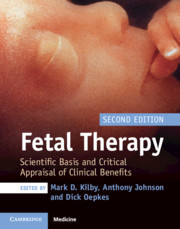Book contents
- Fetal Therapy
- Fetal Therapy
- Copyright page
- Dedication
- Contents
- Contributors
- Foreword
- Section 1: General Principles
- Section 2: Fetal Disease: Pathogenesis and Treatment
- Red Cell Alloimmunization
- Structural Heart Disease in the Fetus
- Fetal Dysrhythmias
- Manipulation of Fetal Amniotic Fluid Volume
- Fetal Infections
- Fetal Growth and Well-being
- Chapter 23 Fetal Growth Restriction: Placental Basis and Implications for Clinical Practice
- Chapter 24 Fetal Growth Restriction: Diagnosis and Management
- Chapter 25 Screening and Intervention for Fetal Growth Restriction
- Chapter 26 Maternal and Fetal Therapy: Can We Optimize Fetal Growth?
- Preterm Birth of the Singleton and Multiple Pregnancy
- Complications of Monochorionic Multiple Pregnancy: Twin-to-Twin Transfusion Syndrome
- Complications of Monochorionic Multiple Pregnancy: Fetal Growth Restriction in Monochorionic Twins
- Complications of Monochorionic Multiple Pregnancy: Twin Reversed Arterial Perfusion Sequence
- Complications of Monochorionic Multiple Pregnancy: Multifetal Reduction in Multiple Pregnancy
- Fetal Urinary Tract Obstruction
- Pleural Effusion and Pulmonary Pathology
- Surgical Correction of Neural Tube Anomalies
- Fetal Tumors
- Congenital Diaphragmatic Hernia
- Fetal Stem Cell Transplantation
- Gene Therapy
- Section III: The Future
- Index
- References
Chapter 23 - Fetal Growth Restriction: Placental Basis and Implications for Clinical Practice
from Fetal Growth and Well-being
Published online by Cambridge University Press: 21 October 2019
- Fetal Therapy
- Fetal Therapy
- Copyright page
- Dedication
- Contents
- Contributors
- Foreword
- Section 1: General Principles
- Section 2: Fetal Disease: Pathogenesis and Treatment
- Red Cell Alloimmunization
- Structural Heart Disease in the Fetus
- Fetal Dysrhythmias
- Manipulation of Fetal Amniotic Fluid Volume
- Fetal Infections
- Fetal Growth and Well-being
- Chapter 23 Fetal Growth Restriction: Placental Basis and Implications for Clinical Practice
- Chapter 24 Fetal Growth Restriction: Diagnosis and Management
- Chapter 25 Screening and Intervention for Fetal Growth Restriction
- Chapter 26 Maternal and Fetal Therapy: Can We Optimize Fetal Growth?
- Preterm Birth of the Singleton and Multiple Pregnancy
- Complications of Monochorionic Multiple Pregnancy: Twin-to-Twin Transfusion Syndrome
- Complications of Monochorionic Multiple Pregnancy: Fetal Growth Restriction in Monochorionic Twins
- Complications of Monochorionic Multiple Pregnancy: Twin Reversed Arterial Perfusion Sequence
- Complications of Monochorionic Multiple Pregnancy: Multifetal Reduction in Multiple Pregnancy
- Fetal Urinary Tract Obstruction
- Pleural Effusion and Pulmonary Pathology
- Surgical Correction of Neural Tube Anomalies
- Fetal Tumors
- Congenital Diaphragmatic Hernia
- Fetal Stem Cell Transplantation
- Gene Therapy
- Section III: The Future
- Index
- References
Summary
Advances in obstetrical ultrasound technology, combined with newer magnetic resonance imaging (MRI) methods, cell-free fetal DNA testing in maternal blood, and comprehensive molecular testing of the fetus, have greatly improved prenatal diagnostic capabilities in the context of fetal growth restriction (FGR) as shown in Chapter 24. Increased understanding and use of these resources means the likelihood of recognizing a fetal basis for FGR before birth, and managing it accordingly, will increase. The presumption of a placental basis for FGR dominates everyday clinical practice, yet paradoxically at present the application of current knowledge of what constitutes true ‘placental insufficiency’ has not translated into improved maternal care and perinatal outcomes. As an example, 33% of 650 women recruited to the landmark DIGITAT (Disproportionate Intrauterine Growth Intervention Trial at Term) trial had no postnatal evidence of FGR (defined as birth weight <10th percentile) [1]. Since obstetricians manage suspected FGR prior to delivery, they fear a risk of antepartum stillbirth and deploy frequent short-term tests of fetal well-being (biophysical profile, Doppler ultrasound, and non-stress tests), even via hospital admission, in the absence of any objective placental diagnosis. Fortunately, recent advances in the understanding of the placental basis of FGR have led to much-improved precision in both screening for the disease [2, 3] and in the prenatal diagnosis of the placental basis of FGR [4]. This chapter is designed to equip obstetricians, midwives and maternal–fetal medicine sub-specialists with key concepts in placental development and pathology that directly contribute to the care of women with suspected FGR pregnancies.
- Type
- Chapter
- Information
- Fetal TherapyScientific Basis and Critical Appraisal of Clinical Benefits, pp. 248 - 263Publisher: Cambridge University PressPrint publication year: 2020



